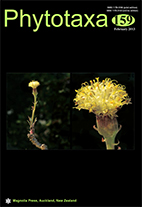Abstract
Previous molecular phylogenetic studies of Pelargonium have remained inconclusive with respect to branching patterns of major infrageneric lineages, with the exception of a basalmost generic split that reflects chromosome length differences. Because of this and the lack of clearly distinguishing morphological characters, no subgeneric classification has been undertaken so far. Here, we present increased phylogenetic signal using chloroplast atpB-rbcL spacer and trnL-F sequences including additional taxa (110 taxa in total) and character sampling. All analyses confirmed the previously recognised first split into two clades characterised by chromosome size, and also converged on four major clades (two within each chromosome size group). The four major clades are further supported by synapomorphic length mutations from both intergenic spacers. The evolution of characters from flower morphology and phenolic constituents was examined for usefulness for clade delimitation. Although character state distributions did not generally reveal clear synapomorphies for the respective lineages, differences in state distributions of floral characters and leaf phenols support the circumscription of these major clades. In particular, nectar guides and petal-ratios indicate character state shifts among clades. The leaf flavonoids, myricetin and prodelphinidin, exhibit differing evolutionary trends in Pelargonium species with small chromosomes. In summary, all results favour the recognition of four, morphologically diagnosable, lineages as subgenera and support a revised subgeneric classification of Pelargonium. In addition, a new section (stat. nov.) including two subsections (comb. nov.) is segregated from an otherwise paraphyletic section Polyactium.

